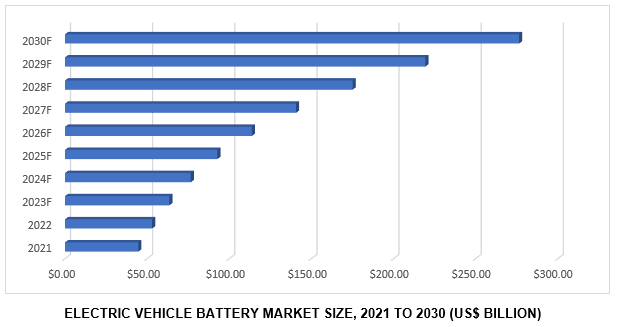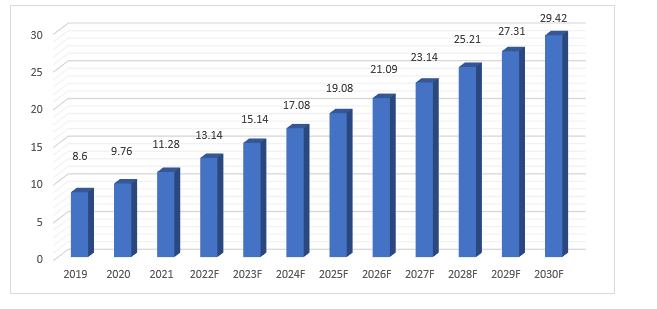Impulsando la movilidad eléctrica: revolucionando la gestión de baterías con la integración de la nube y el IoT
La tecnología IoT y la computación en la nube se combinan en el sistema de gestión de baterías en la nube. El IoT se utiliza para alertar al fabricante y a los usuarios sobre el estado del paquete de baterías en tiempo real gracias a los avances en la arquitectura de software BMS para sistemas de notificación y replicación remota.

El tamaño del mercado mundial de baterías para vehículos eléctricos se estimó en 53.080 millones de USD en 2022 y se espera que alcance los 276.400 millones de USD en 2030 con una TCAC registrada del 22,9% durante el período de pronóstico de 2022 a 2030.
La experiencia del vehículo eléctrico está íntimamente correlacionada con la viabilidad de las baterías de iones de litio porque el paquete de baterías del vehículo eléctrico representa el 50% del costo total de propiedad del automóvil.
Sistema de gestión de baterías: su uso, necesidad y beneficios
ElSistema de gestión de baterías (BMS) es un sistema electrónico que supervisa, equilibra y protege el paquete de baterías de un vehículo eléctrico. Supervisa el Estado de Carga (SoC), el Estado de Salud (SOH) y el Estado de Potencia (SoP) de la batería para garantizar que funcione de forma eficaz y segura. También equilibra las celdas para garantizar que se mantenga el mismo voltaje en todas las celdas y recopila datos del paquete de baterías para utilizarlos en funciones basadas en el análisis.
Principales tendencias en la tecnología de baterías
La sofisticación del software BMS:La mejor estimación del estado de la batería y la gestión de la vida útil y el rendimiento de la batería están en aumento. La información precisa sobre el rendimiento del mundo real ha mejorado los modelos BMS. Para ello, se utilizan modelos de batería multifísicos autooptimizables, así como modelos habilitados para IA autoactualizables y parametrizables.
Arquitecturas de vehículos de mayor voltaje:Topologías de 400 V para un uso de alta energía y rentable. Primer uso de 800 V en industrias de alto rendimiento. Para vehículos todoterreno, un sistema de 1200 V. Las corrientes más altas y la carga más rápida requieren un BMS escalable.
Avances en la monitorización de baterías:Las celdas individuales se pueden supervisar y controlar mediante sensores integrados inteligentes. Además, aísla una celda o toma energía de un subconjunto de celdas, ayuda a la autorreparación y aumenta la vida útil de las celdas.
BMS habilitado para la nube:La monitorización de la batería y la estimación del estado se basan en el gemelo digital. Las transferencias de datos inalámbricas ayudan a ajustar el BMS en función del conocimiento actual del sistema. El rendimiento y la vida útil de la batería se mejoran mediante el análisis de big data. El uso y la aceptación de las baterías de segunda vida se mejoran con datos detallados de la batería.
Número de dispositivos conectados al Internet de las cosas (IoT) en todo el mundo de 2019 a 2021, con previsiones de 2022 a 2030 (en miles de millones)

IONDASH: El sistema de gestión de baterías en la nube más avanzado de la India
La batería se puede examinar y rastrear mediante IONDASH, un sistema de gestión de baterías basado en IoT. El paquete de baterías está protegido contra cualquier pico de corriente y voltaje no deseado mediante una protección de circuito de fusible integrada.
Se puede acceder fácilmente a IONDASH para aquellos que utilizan un navegador web. El sistema de gestión de baterías en vehículos eléctricos puede volverse más eficiente y útil con la ayuda de esta plataforma IoT en la nube.
Conclusión
Coche eléctrico Los paquetes de baterías están protegidos por el sistema de gestión de baterías basado en IoT a través de la monitorización remota del hardware. Esta solución de rendimiento de batería más segura y confiable se creó utilizando hardware y software BMS. BMS puede mostrar información pertinente en línea, incluida la ubicación, el estado del paquete de baterías y la temperatura durante la carga y la descarga. El sistema de gestión de baterías basado en IoT habilitado para la nube, que está alimentado por GPS, encuentra las geocoordenadas precisas y las presenta en la página web de BMS.
Autor: Bobby Singh
